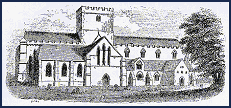
The Reformation in Wales 3
The dissolution of the monasteries
Exploitation of church assets
Once Henry VIII had established the crown as head of the church
in his realm then he had the legal power to exploit the possibilities
of stripping the church of much of its wealth. Thomas Cromwell,
the King’s agent in matters spiritual, sent out deputies
to visit cathedrals and monastic houses report on their condition
and assess the value of their properties and estates.
The three deputies who visited sites in Wales appear to have
been reasonable in their approach and actually commended Carmarthen
Priory on the state of buildings and the behaviour of the prior.
Many of the monastic settlements were in debt to the local gentry
or were being in part managed by lay officers from this class
who were therefore keen to protect their own interests and exploit
any opportunities created by the ending of monastic life.
Even the most devout landowners did nothing to defend a monastic
world in decline. Strata Marcella near Welshpool had actually
been sold to Lord Powis by the time of the dissolution. The years
1536 to 1538 saw the closure of all of Wales’ monasteries
and friaries, some by Act of Parliament, and some under pressure
from crown agents.
Lost vocations
These closures left around 250 monks, nuns and friars in Wales
without a home or vocation. They received a modest but regular
pension and some of the more senior clergy were able to find
livings in nearby parishes. The many lay workers who served the
monasteries as servants and labourers may well have continued
to work for their new landlords. The monasteries themselves were
quickly stripped of all their movable assets and auctions were
often held on the site.
 In Brecon the monastery
church of
In Brecon the monastery
church of
St John the Evangelist (left)
continued as a parish church, and the friary became a grammar
school.
Sir John Price, himself a member of the
visitations which assessed monasteries, took advantage of his
position and secured the Brecon Priory buildings for himself.
Elsewhere the monastic buildings became convenient sources of
dressed stone for local building projects or were converted to
domestic use. Monastery estates were awarded as gifts from the
crown to reward loyalty or were leased or sold to local gentry,
many of whom would have been former tenants or lessees of abbey
lands. At Cwm-hir in Radnorshire, Sir John Williams built a large
estate in this way.
There are 4 pages on the Reformation in Wales. Use the box links below to view the other pages.